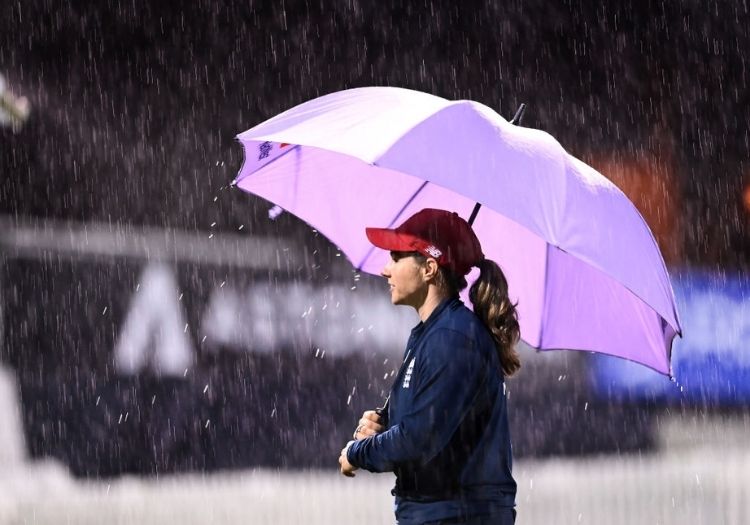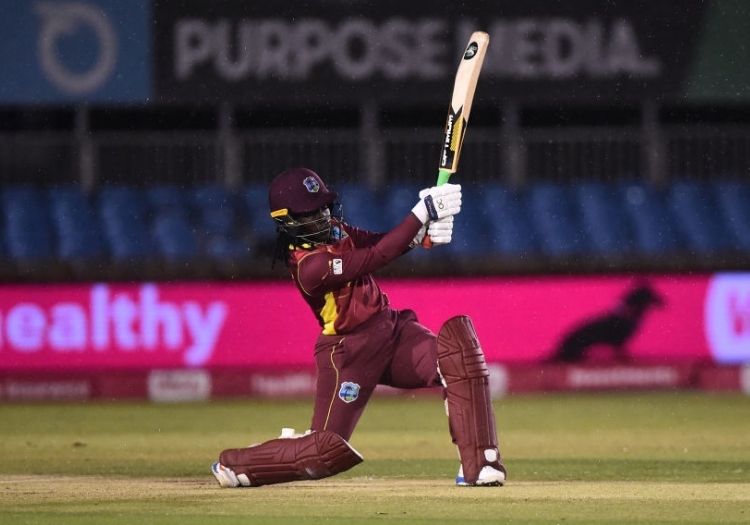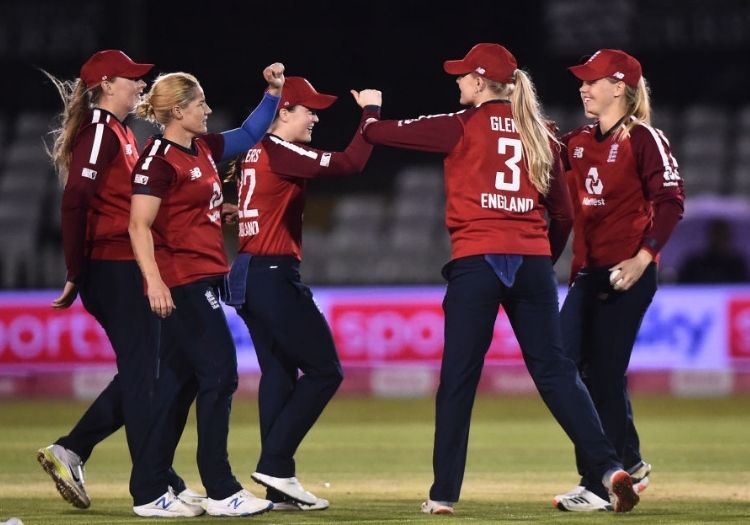NICK FRIEND AT DERBY: There was something strangely fitting about having to wait until the last possible moment for any cricket to break out, before having to make do with something altogether different from what was originally scheduled

I blinked. And just like that, I missed it. It was gone. The international summer. Gone with a click of the fingers, Stafanie Taylor and her side disappearing into the autumnal darkness and onto chartered flights home.
It was a shame that it had to end as it did, a five-over swing under soaking skies. It felt frustratingly unsatisfactory, even if – in its own way – there was something strangely fitting about having to wait until the last possible moment for any cricket to break out, before having to make do with something altogether different from what was originally scheduled.
And maybe, given these strange times, it was only right that England should chase down a total of 42 for the loss of seven wickets, including three kamikaze runouts. Ultimately, the final ball of international cricket delivered in the United Kingdom in 2020 was a head-high beamer.
Yet, in truth, it was a triumph that we had a summer at all.
Just as English cricket had pulled a rabbit out of the hat in the first place, now with a wave of a wand and the flash of a handkerchief, it has been magicked away once more – not to be seen until well into the new year. We have all witnessed how much the global landscape can shift in this intervening period, so hopefully – and it is only hope rather than expectation – the outlook will be more positive upon its return.
The immense gratitude we feel to all those who opted to travel will only increase with time: two West Indies squads, Australia, Pakistan and Ireland. One day, that appreciation will grow into something greater.
When the pandemic is behind us and some semblance of normality has returned, we will doubtless reflect on these months and realise our fortune in watching anything at all. Cricket is lucky that its players were so keen to play their game, whatever the journey and wherever it might have taken them.
And it is difficult to speak highly enough of the ECB, who provided leadership when elsewhere it was absent. In a country suffering from a chaotic lack of clarity in the handling of this major health crisis, Steve Elworthy and his colleagues built a bio-secure microclimate, founded on a straightforward premise of competence, expertise and meticulous planning.
Since England’s Test team, led by Joe Root, entered their Ageas Bowl bubble on June 23, not a single positive test for coronavirus has been reported. In three months, there was just a single blemish, but that was handled transparently, taken seriously and nipped in the bud. Their biggest challenge, as ever, was the weather – typified on a wintry night in Derby that brought it all to a close after a 150-minute wait for the rain to abate.
I recall sitting in on a Zoom call with Elworthy, a genuinely heroic figure in this summer of unsung heroes, at the end of May. He spoke for half an hour in forensic detail on every iota of his mission statement. At times, it was difficult to follow. Certainly, on a journalistic level, it was challenging afterwards to pick out the key takeaways from a sermon of complexities that were new to us all.

The weather threatened to ruin the chances of play in Derby
But I also remember thinking that we were in good hands. Even when Clare Connor had spoken three weeks earlier to temper expectations for the women’s game, admitting that sacrifices might have to be made in the short-term in order to safeguard a prosperous future, she did so with a measure of reassuring transparency.
“We have to be really realistic,” she stressed. “If the international women's schedule can't be fulfilled in full but a large amount of the international men's programme can this summer, which is going to reduce that £380m hole, we have to be realistic about that.”
That warning was caveated, though, with the comfort that women’s international cricket was “completely integrated into the behind closed doors project” that Elworthy would later spell out. Writing this from inside the media gazebo at an otherwise secluded Incora County Ground – my temperature taken upon entry to each of the five games, she was true to her word.
In fact, almost everything she forecast in a press conference short on bluster but heavy on candour came to pass – a remarkable achievement in itself, given the roadblocks that would later present themselves.
“I would be devastated if there was no international women’s cricket this summer,” she added. “No one would be more disappointed.”
And from those thoughts alone, you got the sense that there would be something. No one quite knew what, but you could be somewhat soothed by the knowledge that these were the figures charged with working it out.
Tom Harrison: Ambitions for women's game not diluted by impact of pandemic
There were certainly moments when confidence might have waned. England’s players found out via Twitter that next year’s World Cup had been pushed back by a year, before South Africa were forced to pull the plug on their planned tour on August 18 – just 43 days ago. Connor subsequently admitted that she was “immensely disappointed,” and suddenly doubts were raised.
Heather Knight’s squad, meanwhile, had been training together since late June. But for what?
“There was a big worry,” seamer Kate Cross told The Cricketer. “It was quite a difficult couple of days as a team motivation-wise (when South Africa withdrew).
“You’re in the middle of that bubble in Derbyshire, thinking: ‘Why are we here? What are we training for?’ It was pretty difficult actually.
“You could see what hard work it had been and how different Derbyshire looked from when we would normally play there. Once all that was in place, I was thinking: ‘There’s no reason for a team not to come over now.’
“I didn’t put into consideration the fact that their government might not allow it. It had all been such positive talk about us playing that I just assumed that we would be.”

Deandra Dottin was back to her best after a long spell out injured
India, of course, had already opted out. They had initially been due to arrive for a series in June, though those plans were quickly abandoned. A secondary hope that they might then take part in a late-summer tri-series with South Africa never came to fruition either.
It was heartening, therefore, to hear Tom Harrison speak on Saturday ahead of the third match of this series, which was simulcast by Sky Sports and the BBC and streamed on YouTube.
“We just couldn’t have a situation where we didn’t play any international women’s cricket,” he said, adding that even if West Indies had been unable to tour, there were further irons in the fire – Ireland had been suggested by some on social media as a possible alternative.
Knight put it in her pre-series press conference that this, as much as anything, represented a significant step forward.
“We knew as players that they were going to do everything in their power to try to get some cricket on,” she explained.
“They’ve done exactly what they would have done for the guys, which is real progress. I don’t think that would have happened three or four years ago. I think we knew there was a good possibility that we’d be playing.”
And so, against all reasonable logic, an international summer was devised. Had it not materialised, it would have been no failure – a disappointment, yes, but never for a lack of trying.
According to Cricket West Indies chief executive Johnny Grave, discussions around the possibility of a series took “under two weeks” from beginning to end.

England won the first four matches comfortably
There was less than a month between confirmation of the tour going ahead and the first match getting underway. And once the cameras arrived at Derbyshire’s Incora County Ground – an unlikely saviour for international cricket, it was all over in 10 days.
As a result, it is difficult to quite know what we have learnt or, indeed, how to judge the cricket we have seen.
The first four games were carbon copies of one another. England batted first, fashioning totals of 151, 154, 163 and 166. They won each by 20 runs, 44 runs, 47 runs and 47 runs. The run-scoring has been shared around: Knight, Nat Sciver, Tammy Beaumont and Amy Jones all helped themselves to more than 100.
Likewise, the wickets have also been spread across seven bowlers. But you sensed they were never at their best. The chaos that engulfed their chase tonight suggested that there remains plenty to work on in terms of game management.
For West Indies, Deandra Dottin has been the major positive – the series’ leading run-scorer by a stretch and resembling something like her former self, even with the ball.
Beyond her, however, there has been little to shout about; only Dottin and Taylor have made more than 38 runs. But at the same time, the tourists arrived in England cold, with Covid-19 restrictions across the Caribbean preventing much meaningful preparation from taking place, and on the back of a dismal T20 World Cup display. They improved with each game and will feel like they missed an opportunity to creep over the line on the last evening of the tour.
So, what did we learn? I’m not really quite sure, in all honesty. But maybe this time, that doesn’t matter. Perhaps, at the end of it all, what matters is that it happened.
For unrivalled coverage of the county season, subscribe to The Cricketer and receive 3 issues for £5